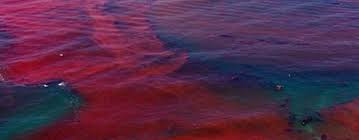Red Tide – A Manatee’s Unfortunate Reality

Greetings! You’ve probably read some of my previous blogs on manatees and heard me explain how, “Manatees have no enemies.” Well in general, we don’t have any enemies. That’s right … sharks and alligators are not our enemies! However, an unfortunate condition known as red tide happens to be one of our two main enemies. The other is actually watercraft strikes caused by humans. Today, I’d like to focus on the extreme dangers of red tide.
Dr. Richard Stumpf, oceanographer for the National Oceanic and Atmospheric Administration (NOAA) said, “Red tide is a general term for harmful algal blooms (HABs) in the ocean. There are many different algae that are described as red tide.These harmful algal blooms usually make the water reddish brown. Most of the red tide organisms are able to swim up and down in the water.”
So how can it be that insanely small microscopic algae called Karenia brevis, also known as red tide, have the ability to kill hundreds of large majestic manatees in a very short period of time? It’s because of the deadly toxin they produce which is known as brevetoxin.
These harmful algal blooms come together when the algae in the water suddenly begin growing out of control. Think of it as an underwater volcano exploding and releasing all of its debilitating effects in all directions, even into the air. Warm water temperatures, along with coastal fertilizer drainage can bring on these dangerous and deadly HABs.
And when manatees eat seagrass where the HABs have attached themselves, they ingest the toxin. The sobering news here is if the manatee is not treated in time, it could die from the poisonous toxin because it affects the respiratory system. Additionally, other marine mammals, fish, shellfish, birds and even people can become exposed to these toxins. In very rare cases HABs can even be fatal to humans. Usually, for humans however, these toxic gases released from the blooms usually just cause sore throats and stinging eyes.
Unfortunately, one of the geographic locations for HABs occurs right along Florida’s Gulf Coast. It’s usually during the spring and summer months when this raging algae growth occurs. However red tide organisms are actually found in Florida’s waters every month of the year. Like the name indicates, the water turns an intense red when HABs are active.
For the last several years, the scientists at the National Ocean Service have been monitoring and recording HABs. They are trying to learn more about actually forecasting bloom locations so they can warn communities of the upcoming environmental consequences brought on by red tide.
If you are in Florida and you see a sick or injured manatee, please call the Florida Fish and Wildlife Conservation Commission at: 1-888-404-FWCC. They are the folks who are responsible for rescuing us in Florida.
Here’s the Save the Manatee Club link to learn more about us manatees …
Here’s a cool link for you to learn more about how we’re rescued and brought into rehabilitation …